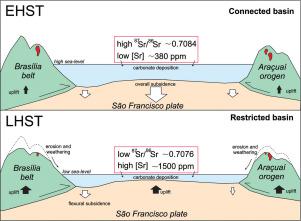Gondwana Research ( IF 6.1 ) Pub Date : 2021-02-26 , DOI: 10.1016/j.gr.2021.02.007 Cristian Guacaneme , Marly Babinski , Carolina Bedoya-Rueda , Gustavo M. Paula-Santos , Sergio Caetano-Filho , Matheus Kuchenbecker , Humberto L.S. Reis , Ricardo I.F. Trindade

|
The Bambuí Group is a marine sedimentary record of an intracratonic foreland basin developed at the terminal Ediacaran and early Cambrian during the assembly of West Gondwana. Here we present a basin-scale high-resolution Sr isotope stratigraphy for the basal Bambuí Group, aiming to understand the spatial and temporal variations of the 87Sr/86Sr ratios and to explore the controls over the Sr isotope system in intracontinental marine environments. Assessment of the stratigraphic evolution of both Sr concentrations and Sr isotopes shows a major increase in Sr/Ca ratios (up to 0.004) and a decrease in the 87Sr/86Sr ratios from 0.7086 to 0.7076 in the high stand system tract of the basal 2nd-order sequence. These changes precede a large positive δ13C excursion typically found across the basin in the middle Bambuí Group. The high variability of both 87Sr/86Sr and Sr/Ca ratios was not caused by globally uniform changes in isotopic compositions of seawater, but rather likely reflect marine restriction and paleogeographic changes of the depositional environments at basin scale. This would result from the tectonic uplift of Neoproterozoic orogenic belts around the São Francisco craton, which generated an isolated foreland marine basin. Compared to the global ocean, such a smaller intracontinental reservoir would be more sensitive to the Sr isotope composition from the different rock sources. We suggest that changes on the balance between carbonate production and accommodation associated with tectonically-related flexural subsidence progressively modified the continental drainage patterns, sedimentary sources and the chemical weathering regimes, altering the strontium influxes and isotopic compositions of the seawater in the early Bambuí basin cycle. Similar anomalies in the strontium isotope record are also recorded in coeval marine basins across West Gondwana and suggest that tectonics might have played an important role on seawater chemistry at the Neoproterozoic-Paleozoic transition.
中文翻译:

古代限制海中构造诱发的锶同位素变化:以巴西东部的Ediacaran-CambrianBambuí前陆盆地系统为例
Bambuí组是西贡多瓦纳组装期间在Ediacaran终端和寒武纪早期发育的克拉通前陆盆地的海洋沉积记录。在这里,我们为基础班巴伊组提出了盆地规模的高分辨率Sr同位素地层学,旨在了解87 Sr / 86 Sr比值的时空变化,并探索在大陆内部海洋环境中对Sr同位素系统的控制。对Sr浓度和Sr同位素的地层演化的评估表明,Sr / Ca比值显着增加(最高0.004),而87 Sr / 86值降低了。在基础二阶序列的高位系统道中,Sr比从0.7086到0.7076。这些变化先于大的正δ 13通常整个盆地发现在中间BambuíC组偏移。87 Sr / 86的高可变性Sr和Sr / Ca比值不是由海水同位素组成的全球统一变化引起的,而是可能反映了海洋限制和盆地规模沉积环境的古地理变化。这是由于圣弗朗西斯科克拉通周围新元古代造山带的构造隆升造成的,从而形成了一个孤立的前陆海盆。与全球海洋相比,这样一个较小的洲内储层将对来自不同岩石源的Sr同位素组成更加敏感。我们建议,碳酸盐岩产量和与构造相关的挠性塌陷有关的适应性之间的平衡变化会逐步改变大陆的排水方式,沉积物来源和化学风化机制,在班布河流域早期的周期中改变了锶的涌入量和海水的同位素组成。锶同位素记录中的类似异常也记录在整个冈瓦纳西部的近代海盆中,这表明构造学可能在新元古代-古生代过渡中对海水化学起了重要作用。



























 京公网安备 11010802027423号
京公网安备 11010802027423号